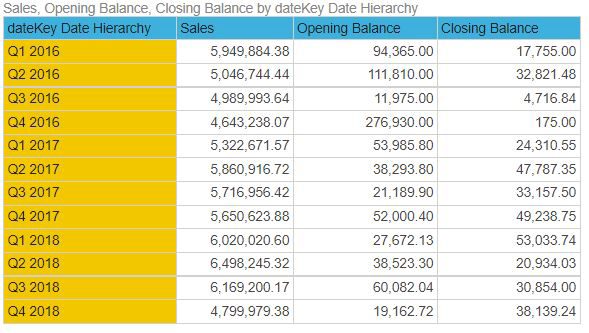The Last Child or First Child measure takes the last instance at the lowest level of the regular hierarchy for that parent or the first instance at the lowest level for that parent respectively in a regular date-time hierarchy as the total when a date-time regular hierarchy is added to the query, without the need to create any custom business logic. If the date-time attribute is not a hierarchy (Like Full Month or Full Quarter) then Last Child will return the last value at the lowest level of granularity available based on that date-time attribute. For all hierarchies other than date-time, the measure uses SUM to total the values. This is particularly useful when working with parent child accounting hierarchies when working with semi additive measures like Cash Balance, but can be used for any query containing a date-time hierarchy.
The Last Child or First Child measure is applied to the numeric measure column whose Last or First Child value you want to display. For example, if you want to see the Last Child Cash Balance for each quarter, you'll add the Last Child measure to the Sales column. When Sales and Month (or any other date-time column) are added to the query, the values for sales will be displayed for the Last Child of that quarter (typically the last day, like March 31st, or the last day that contains data for Sales).
The Last Child or First Child measure can be set for numeric measure columns from the Tables panel, the Measure Editor, or the Multi Measures panel.
Note: This feature is available with an Enterprise license only.
In this example, the Multi Measure panel was used to add a Last Child (Closing Balance) and First Child (Opening Balance) derived from the Sales measure.

Sales and Opening Balance and Closing Balance were added to the query, along with Full Quarter. We can now see quarterly Sales and quarterly Opening and Closing Balance for each Quarter side by side:
